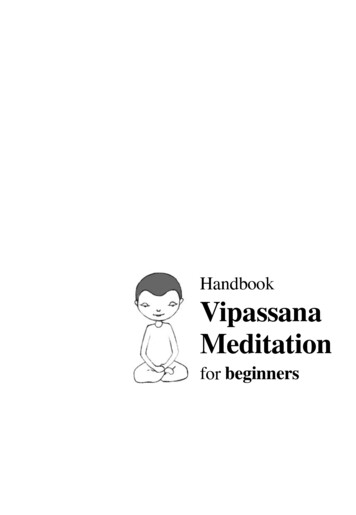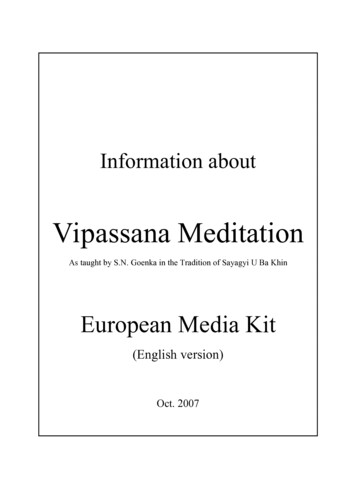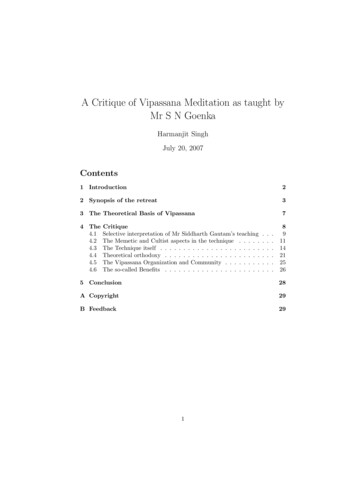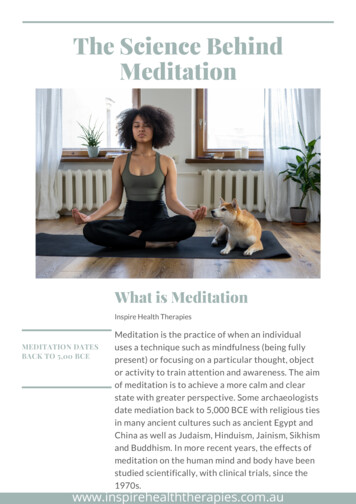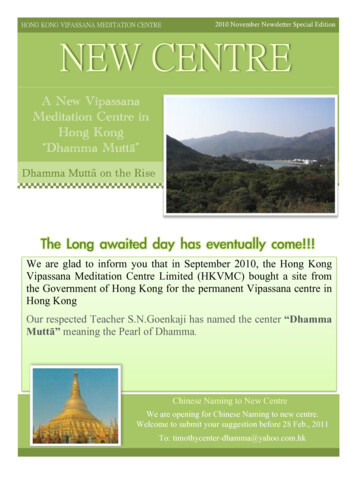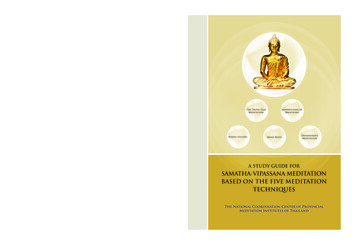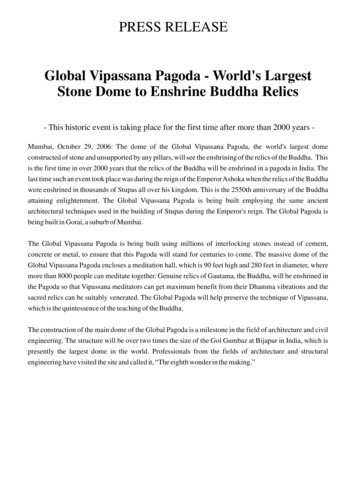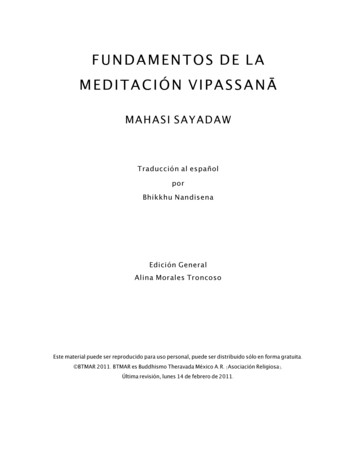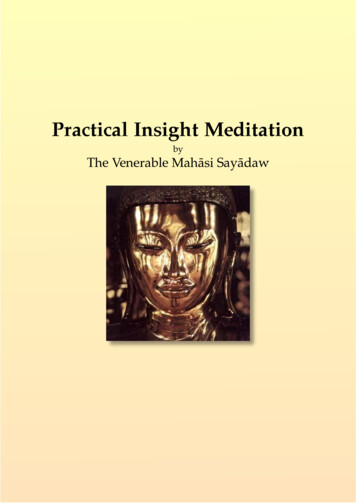
Transcription
HandbookVipassanaMeditationfor beginners
HandbookVipassana Meditationfor beginnersby Phra Athikan Somsak SoradoAbbot of Wat Bhaddanta AsabharamFirst edition 1,000 copies May 2009Print SMK Printing Co.Ltd ; Bangkok , ThailandISBN 978-974-94671-2-1Art WorkIllustratorDesignsabaya.multiply.comChavisa ChawalitsaeweeBhusit Indraduta copyright ; No reservations for copyright. Dhamma is freely given; allmay freely copy and print this handbook.Published for Free DistributionSAPPA DANAM DHAMMA DANAM CHINATI“TO OFFER DHAMMA AS A GIFT EXCEEDSALL KINDS OF OFFERINGS”
PrefaceThis is a beginners’ handbook for awarenessdevelopment according to the Four Foundations ofMindfulness. I have compiled here a set of instructionsfrom my own personal experience that I have heard, read,written and taken into memory from the Tipitika and otherBuddhist texts. I have received instructions fromMeditation Masters of the Vipassana Lineage that I havedirectly and intensively put into practice. VipassanaMeditation Grandmaster Dr. Bhaddanta Asabha Mahatherawas my kalyanamittata who gave instructions andinterviews with good results.The core substance of this handbook has beencompiled directly from personal experience andisespecially for meditators who wish to put the instructionsinto practice. Many meditators have provided feedbackthat they have greatly benefited from this handbook andthat they have received good results to a certain extent.They further urged that more copies should be printed andthat they were willing to sponsor the cost of printing.Before being compiled, this manual only consisted of afew pages of notes which I had distributed to meditatorswho came to practice. Later, all the notes were compiledinto a handbook.
I hereby give permission to those who wish to printthis handbook and distribute it. I do not make reservationsfor copyright. Dhamma is freely given; all may freelycopy and print this handbook.For those that have yet to directly experiencevipassana meditaton according to the Four Foundations ofMindfulness this handbook will give instructions on whatand how to physically and emotionally prepare oneselfbefore entering into a meditation retreat. Core principlesand method are elaborated – including standing, walking,sitting, lying down, lowering the body, lifting the body up,and stretching. The benefits of Vipassana Meditation arealso given. This book further elaborates on bare awarenessof knowing pleasant feelings, painful feelings, neitherpleasant-nor-painful feeling, the bare awareness ofknowing the thinking process, the five hindrances, internalsense fields, external sense fields including the bareawareness of the Four Foundations of Mindfulness(mindfulness of body, feelings, thoughts and ideas), as itreally is.While reading thisbook, one may feel that it is notenjoyable as the handbook is filled with instructions,general principles, method of practice, and theencouragement to put instructions into direct practice; andeventually to reap the benefits of Vipassana Meditation indue course. One must put the method laid out here intopractice to assure oneself that this meditation method
really works. Thus, this handbook is not a scholarly studynor a book for recreation.Finally, it is hoped that this handbook will be a goodfriend for beginnersand will provide a firm foundation forthose who walk the path towards liberation andenlightenment. For those who see the dangers of thecontinued rounds of existence, Samsara, and for those onthe journey towards the path toward liberation, may theyall be well. May the wholesome cause and effecteventuallylead them to the shore of Nibbana.Anumodana and thank you to the translators,financial sponsors and all those involved in publishing thisfirst edition of the Handbook of Vipassana Meditation forbeginners. The opportunity in spreading the Dhamma or infreely giving the Dhamma, the Buddha has stated as beingthe highest act of generosity.I hereby pay respects to the Triple Gems and may theTriple Gems offer protection to all – to be free fromdiseases, having wisdom and right understanding; and mayall be successful in their life endeavors.With MettaPhra Athikan Somsak SoradoAbbot of Wat Bhaddanta Asabharam
ContentsPrefaceHow to prepare before entering into Vipassana MeditationMethod of accepting the eight Precepts andmeditation retreatMeaning of ContemplationVipassana MeditationContemplation of body (Kayanupassana)Standing ContemplationWalkingTurningWalking stage 1Walking stage 2Walking stage 3Walking stage 4Walking stage 5Walking stage 6Sitting MeditationSitting meditation with two-step acknowledgingSitting meditation with three-step acknowledgingSitting meditation with four-step acknowledging91521222424262629323435363839404142
Contemplation of sleepingContemplation of other activitiesExample of contemplation of other activitiesContemplation of feelings (Vedananupassana)Three methods to contemplate VedanaContemplation of mind (Cittanupassana)Contemplation of phenomena (Dhammanupassana)Contemplation of hindrances (Nivarana 5)Benefits of Vipassana Meditation practicePrinciples and method of interviewMethod of leaving the meditation practiceAppendixBiographyHistory of Wat Bhaddanta AsabharamRules and regulations for the meditation retreatSchedule for the meditatorVerse of merit 6
Handbook Vipassana Meditation for beginners How to prepare before entering intoVipassana MeditationMany people are worried about how to prepare forentering into Vipassana Meditation, including how toenable to take it through the entire period determined. As aresult of an improper preparation, some cannot meditate aswell as they should. One of the concerns is if the place ortraining center is suitable for the practice. It should beconsidered as follows::1. not far from or close to a village or a community;2. transport easily easy to get to;3. be a quiet place;4. not much noise or smell;5. not a place busy with people coming and going;6. not a recreation or attractive place causing themind to be unsettled or easily bothered;7. be full of shade of trees but sunlit, air easilyventilated, not too dry or humid;
10 Phra Athikan Somsak Sorado8. less bothered by reptiles and pests;9. in the case of monks, no problem of almsgathering;10. accommodation, facilities and things for livingenough available such as meal, medicines and soon;11. there is a meditation master with goodmoralconduct who has sufficient knowledge of theBuddhist scriptures and experience of VipassanaMeditation, and is sophisticated and able toadvise the right methods of the meditation and tobalance the faculties of the meditator;12. review the regulations of the place. For instance,how often the meal is provided in a day,vegetarian or simple, whether the supplementarydrink is provided or not and when it isavailable.Some places provide meal for the monk andmeditator once a day, but some do it twice a day.Some provide the supplementary drink, whilesome do not. Some allow the meditator to bringthe drink by himself/herself. At Wat BhaddhataAsabharam, the meal is provided for the monkonce a day and twice for the meditator; the monkreceives it with the Buddhist alms bowl. And thedrink is available and the meditators are allowedto bring it themselves.allowed the meditator tobring by oneself;
Handbook Vipassana Meditation for beginners 1113. the regulation of sleeping varies from theplaces. Some places allow sleeping at day andmeditating at night, while the others do not andhave a limit to the amount of sleep, only four tosix hours. So the physical and mental readiness isnecessary, otherwise it will be difficult for thepractice;14. to get ready, the practice schedule should bestudied. The meditator should get up early (3:30a.m.) and go to sleep late (10:00 p.m.). Thosewho are inexperienced and unfamiliar to theschedule should try to practice at least 6 hours aday. While those who are experienced shouldmeditate continuously at least 18 – 21 hours aday;15. talking may be allowed at some places, but in thecourse of practice at Wat Bhaddhata Asabharam,it is prohibited if not necessary, except in thetime of interview;16. whatever activities and movements generally areproceeded in a slow mode or manner such asstanding, sitting, laying down, having a meal,drinking and so on. So it is important to acceptthe condition since the beginning, abandon allfamiliarity, and aim to contemplate the activitiesand movements consciously in no hurry;
12 Phra Athikan Somsak Sorado17. normally led by defilements, the meditator needsto contemplate all the objects attentively to keepthe sense-doors (eye, ear, nose, tongue, body, andmind) away from it. Doing well from thebeginning on will cause the practice to developrapidly;18. cut down all kinds of worries and onlyconcentrate on the present as the past is gone andone is not able to do anything, the future has notcome yet and so there is nothing to worry about.The best thing to do is to focus on the materialityand mentality currently existing. Try to recognizethe truth, do not seize or foresee such things:1) Worry about residence (Āvāsaalibodha),one is worried about one’s house or residencethat it may be unclean or messy as there isnobody taking care of it;2) Worry about patron (Kulapalibodha), one isworried about the sponsored family or peoplethat one respects, and afraid that one isunable to keep contact with and get supportfrom those acquaintances;3) Worry about gains (Labhapalibodha), one isworried about the income or one’s usualbenefits that may be reduced or lost becauseof one’s absence;
Handbook Vipassana Meditation for beginners 134) Worry about companions such as friends(Gaṇapalibodha) teachers, students, otheracquaintances and so on;5) Worry about job (Kammapalibodha), one isworried about taking care of constructions,one’s job, business, career,and so on;6) Worry about journey (Antadhānapalibodha),one is worried about one’s planned businesstravel, overseas trip or vacation, and so on;7) Worry about relatives (Ñātipalibodha),one is worried that during one’s absenceone’s parents, children, wife or husband, orclose relatives may get into some troubles orhave some illness;8) Worry about illness (Ābādhapaliodha), oneis worried about the existing illness that itmay become worse, or being ailing due tothe change of weather;9) Worry about education or teaching(Ganthapalibodha), one is worried about notbeing able to catch up on the class or preachto the congregation;10) Worry about power (Iddhipalibodha), one isworried that one’s authority will decrease orbe transferred to others, or that one will losethe opportunity to succeed in any field as oneis taking the course of practice, and so on.
14 Phra Athikan Somsak Sorado19. when determined to take the retreat, one shouldbe ready to the following:1) leave any uniform, title, rank, pride, and soon behind, and make oneself simple;2) bring enough clothing and personal articles,the layman should wear white;3) bring one’s bed articles such as bed andpillow, sheets or blanket, if it is not availableat the place or center;4) leave all accessories behind, except a timer;5) do not come with a severe illness orcontagious disease and bring the medicinesfor it; one should inform the staff oradministration of the place;6) refrain from any activities as regardscommunication such as reading, writing,listening to the radio, watching television,making phone calls; if one bringscommunication tools , leave them at theadministration of the place;7) prepare flowers, joss sticks, and candles forpaying respects to the Triple Gems and themaster;8) do register at the administration office andstudy the regulations of the place.
Handbook Vipassana Meditation for beginners 15Method of accepting the eight Precepts andmeditation retreat1. Make physical and mental readiness for ameditation retreat.2. If possible, provide flower, joss sticks, andcandle for taking the Precepts and meditationretreat.3. Wear proper clothing (white clothes), behavewell and be quiet.4. At the place of ceremony, pay homage to theTriple Gems by raising joined hands and bowingto the ground three times, and another threetimes to the meditation master, then present theflower, joss sticks and candle to the master, recitethe following verse of making a request for theeight Precepts:5. Mayan bhante, tissaranena saha, attha silaniyacama.(O, Prosperous One, we all request for theBuddhist eight Precepts simultaneously with thethree Refuges.)Dutiyampi, mayam bhante, tissaranena saha,attha silani yacama.(O, Prosperous One, we all request for theBuddhist eight Precepts simultaneously with thethree Refuges, for the second time.)
16 Phra Athikan Somsak SoradoTatiyampi, mayam bhante, tissaranena saha,attha silani yacama.(O, Prosperous One, we all request for theBuddhist eight Precepts simultaneously with thethree Refuges, for the third time.)6. The master recites the following passage threetimes, after which the lay people repeat it threetimes.Namo tassa bhagavato arahatosammasambuddhassa.(May veneration be presented to the ExaltedOne, who is an Arahanta or the Passionless One,and who attained Enlightenment by himselfrighteously.)7. The master recites the Three Refuges verse lineby-line, then the lay people recite line-by-lineafter him:Buddham saranam gacchami.(I accept the Buddha as my Refuge.)Dhammam saranam gacchami.(I accept the Dhamma as my Refuge.)Sangham saranam gacchami.(I accept the Sangha as my Refuge.)Dutiyampi buddham saranam gacchami(I accept the Buddha as my Refuge for thesecond time.)
Handbook Vipassana Meditation for beginners 17Dutiyampi dhammam saranam gacchami.(I accept the Dhamma as my Refuge for thesecond time.)Dutiyampi sangham saranam gacchami.(I accept the Sangha as my Refuge for the secondtime.)Tatiyampi buddham saranam gacchami(I accept the Buddha as my Refuge for the thirdtime.)Tatiyampi dhammam saranam gacchami.(I accept the Dhamma as my Refuge for the thirdtime.)Tatiyampi sangham saranam gacchami.(I accept the Sangha as my Refuge for the thirdtime.)The master recites “Tisaranagamanan Nitthitan.” (“TheThree Refuges end here”), then the lay people recite“Ama bhante.” (“Yes, Sir”)8. The master monk recites the Eight Precepts inorder, then the lay people recite in order afterhim:Panatipata, veramani sikkhapadamsamadiyami.(I undertake to observe the precept to abstainfrom taking life of any living being.)
18 Phra Athikan Somsak SoradoAdinnadana, veramani sikkhapadamsamadiyami.(I undertake to observe the precept to abstainfrom taking what is not given.)Abrahma-cariya, veramani sikkhapadamsamadiyami(I undertake to observe the precept to abstainfrom sexual conduct.)Musavada, veramani sikkhapadamsamadiyami.(I undertake to observe the precept to abstainfrom false speech.)Sura-meraya-majja-pamadatthana, veramanisikkhapadam samadiyami.(I undertake to observe the precept to abstainfrom intoxications causing heedlessness.)Vikala-bhojana, veramani sikkhapadamsamadiyami.(I undertake to observe the precept to abstainfrom taking food at inappropriate vilepana-dharana-mandanavighusanatthana, veramani sikkhapadamsamadiyami.(I undertake to observe the precept to abstainfrom dancing, singing, music, unseemly shows,from wearing of garlands, smartening with scents
Handbook Vipassana Meditation for beginners 19and embellishment with unguents.)Uccasayana-mahasayane, veramanisikkhapadam samadiyami.(I undertake to observe the precept to abstainfrom the use of high and large luxurious couchesand beds.)The lay people recite the following verse three times“Imani Attha Sikkhapadani Samadiyami.” (“I requestfor the acceptance of these Eight Precepts.”)9. Make a determination to the Triple Gems byuttering the following verse:“Imahan Bhagava Attabhavan TumhakanPariccayami”(“O, Bles
for copyright. Dhamma is freely given; all may freely copy and print this handbook. For those that have yet to directly experience vipassana meditaton according to the Four Foundations of Mindfulness this handbook will give instructions on what and how to physically and emotionally prepare oneself before entering into a meditation retreat.
